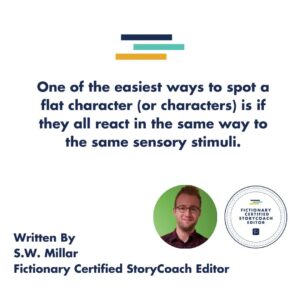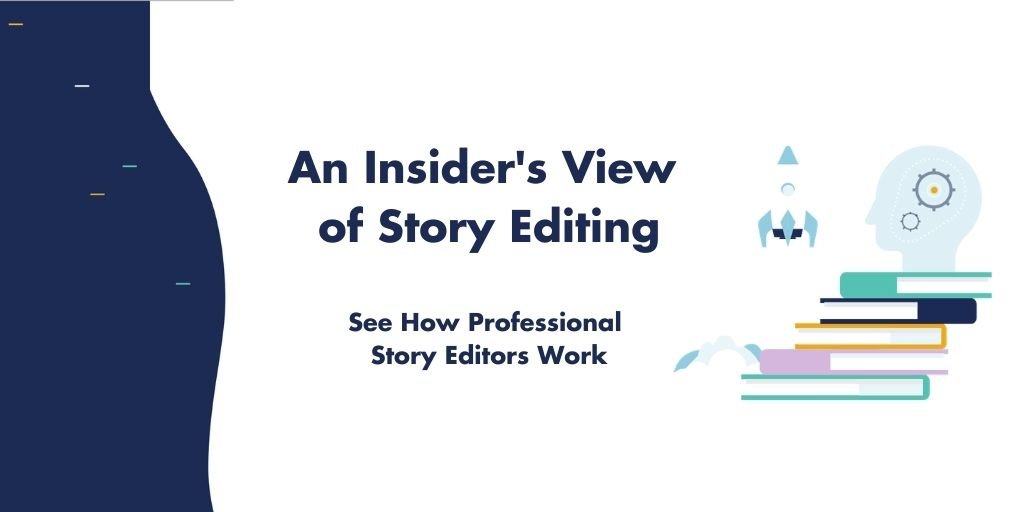
Ah… flat characters, the bane of writers the world over. Are you worried your characters are flatter than steam-rolled pancakes. Struggling to bring your story people to life and make them engaging?
Fear not, my writerly chum. I’ve got you covered.
What are Flat Characters?
Flat characters are characters who lack depth. They’re two dimensional and do nothing but make readers roll their eyes and yawn so wide their jaws crack under the weight of all that flatness.
Flat characters are usually the result of relying on cliches or stereotypes.
Two of the most obvious stereotypes for flat characters are:
Flat Characters—Archetype Example 1: The Squeaky-Clean Hero
These are protagonists who are “all good” with no nuance to their personalities. They always:
- Say the right thing,
- Do the right thing,
- Know how to save the day, and;
- Don’t have any flaws.
I know, I know. Boring, right?
And the second most common stereotype for flat characters?
Flat Characters—Archetype Example 2: The Evil Villain
The truth is few villains are evil for evil’s sake, or rotten to the core. We know when these Dick Dastardly knock-offs come calling because they:
- Twirl their moustaches,
- Cackle like they’ve been puffing on nitrous oxide for weeks,
- Don’t have any motivation for their rapscallion-esque wrongdoings, and;
- Have zero redeemable qualities
I almost nodded off writing that, because the evil villain stereotype is so dull!
Now you know what flat characters are, let’s examine their opposite numbers…

Dynamic Characters
Whereas flat characters are a one-way ticket to Snores-ville, dynamic characters are (as the name suggests) people whom readers want to read about.
Dynamic heroes are so much better than flat characters, because they:
- Mess up sometimes,
- Often say the wrong thing,
- Don’t have all the answers, and;
- Are ridiculously flawed.
Dynamic heroes (and dynamic characters in general) are so readable because they’re relatable, whereas flat characters are about as relatable as dirt.
What about dynamic villans?
Well, they:
- May have moustaches, but seldom twirl them,
- React like any other character would, sans melodrama,
- Have clear, and believable motivations for what they do, and;
- Have plenty of redeeming qualities which give them depth.
So far, we’ve spoken about the difference between flat characters and dynamic characters in terms of personality and, while that’s important (and where you should start if you want to avoid writing a story called, The Flat Character and the Curse of Boredom), it’s not the be all and end all.
There’s another vital story telling tool we can use to add some much needed depth to our characters.
What is it?

Using The Five Senses to Add Depth to Flat Characters
Hang on a minute Shane! The five senses are a setting thing, right? How in the name a Shakespeare’s Twelfth Night can they help us avoid falling prey to writing flat characters.
Great question.
Let’s get into it!
What are The Five Senses?
No surprises here, but the five senses in fiction are the same senses we canny humans use to navigate the world around us on a daily basis. They are:
- Sight: the things we see
- Sound: the things we hear
- Smell: the scents around us
- Taste: the flavours we experience
- Touch: the objects (and emotions) we interact with
While the five senses sit firmly in the setting elements camp, they help the reader experience the world as your point of view character experiences it. That’s crucial because how your characters react to sensory stimuli can show a lot about their personality, and stops them being a flat character.
And the beauty is every character reacts in a different way, which makes them dynamic.
What to know something else that’s super cool about the senses? Hey, don’t hate on me because I’m a huge story nerd! Hopefully, you’re one as well.
But I digress.
The other cool thing about the senses is you can use each one’s superpower to show your character’s reactions in different situations (and make sure they’re not flat characters).
Let me explain what I mean.

The Sensory Superpowers
Each of the five senses has a unique superpower you can use to give your point of view people dynamism and stop them from being flat character fodder.
The key is in their reactions.
Before we get to that, I’d better tell you what the superpowers are.
- Sight Superpower: the ability to describe characters and settings that your point of view character hasn’t encountered before.
- Sound Superpower: the ability to create a sense of atmosphere.
- Smell Superpower: the ability to trigger memories (our olfactory glands are linked to the parts of the brain that story memories)
- Taste Superpower: the ability to pick out tastes unique to the POV character (e.g., the taste of an emotion, or a type of magic, if you write fantasy, etc.)
- Touch Superpower: the ability to heighten emotion in sequel scenes (or steamy scenes, if you write that particular brand of romance)
But how do these sensory superpowers stop us falling prey to flat character syndrome?
Let’s investigate!
Using the Five Sense to avoid Flat Character Syndrome
We’re going to examine each sensory superpower in turn to show how (through the POV Character’s reaction to sensory stimuli) you can avoid creating a flat character.
Let’s take two extremely different made up POV Characters.
Astrid
Astrid is a 25 year old witch who lives in modern day London and attends a university for supernatural creatures. She’s snarky, easily annoyed, and quick to talk back to people (urban fantasy).
Jack
Jack is a 63 year-old retired bricklayer who lives in 1950s Cornwall and solves murder cases as a self-appointed sleuth to while away those retirement hours. He’s mild-mannered, refers to people by their title (never their first name, goodness no!), and only becomes stern as a last resort (murder mystery).
You can see how different these characters are. How do you imagine each of them may react differently to sensory stimuli?
Here’s my interpretation:
Sight
- Astrid meets someone new whom she instantly dislikes on first sight (stimulus). She has no problem telling them so in what most people would describe as a terse manner (reaction).
- Jack meets someone new whom he instantly dislikes on first sight (stimulus). In the interest of diplomacy, he chooses to hold his tongue and reserve judgement (reaction).
Sound
- Astrid hears a branch snap behind her when she’s walking through the woods, alone at night (stimulus). In a split second she’s summoned her magic, whirled around to face her potential attacker and yelled, “You picked the wrong witch to fight with, mate!” (reaction).
- Jack hears a branch snap behind him when he’s walking through the woods (stimulus). Concerned for his safety (and knowing there’s a murderer on the loose) he does the sensible thing and retreats to a public place so he can live to fight another day (reaction).
Smell
- Astrid smells incense (stimulus). She hates that smell because it reminds her of a witch in her COVEN who bullied her when they were kids (reaction).
- Jack smells incense. A slow smile creeps over his face because the smell reminds him of his father, who was a priest.
Taste
- Astrid tastes copper (stimuli). This is good, because it’s what she tastes when her magic works (reaction).
- Jack tastes copper (stimuli). This is bad, because he’s bleeding from the mouth after the killer punched him in the face in the climax (reaction).
Touch
- Astrid’s heart races (stimuli). She’s just spotted her love interest, so this feeling is positive (reaction).
- Jack’s heart races (stimuli). He’s trapped in an abandoned factory with the murderer, so this feeling is negative (reaction).

Conclusion
One of the easiest ways to spot flat characters is if they all react in the same way to the same sensory stimuli.
One person has different background and life experience to someone else, and they way they react to sensory triggers, in a different and dynamic way, to others in your cast, shows their uniqueness and stops you from creating flat characters.
Want more on this topic?
Read this article next: Flat Characters—Definitions and Examples.
Article Written by Shane Millar

Shane Millar is a Fictionary Certified Story Coach and the author of the Write Better Fiction craft guides. He is also the author of the Myth & Magic and Chosen Vampire urban fantasy thriller series.
Shane holds a BA in journalism and is a member of The Alliance of Independent Authors (ALLi). He lives in Buckinghamshire, England.
He has taken too many writing courses to count and enjoys reading as much as possible. Shane is obsessed with five things: the writing craft, mythology, personal development, food, and martial arts movies.
Want to hire Shane to edit your novel? Visit: https://swmillar.com/editing
When do you ever get to see what a story editor delivers to a client if the client is not you?
If you’re thinking of becoming a story editor, this course is for you. Our course gives you an insider’s view of what happens in a story edit. This is similar to a structural or substantive edit for fiction.
Before you hire an editor or edit your own story, it’s important to understand what a story edit is.
Thirteen professional editors edited the same novel.
Each editor worked separately in Fictionary StoryCoach.
This course evaluates their edits and shows you what worked and what didn’t. We’ll show you two scenes before editing and after revisions based on the editors’ suggestions. We even compare the editors’ summary letters and per scene notes.
For writers looking to hire a professional story editor, this course shows you what you should receive from a story editor. It will also show you how an editor might look at your story.’
Sign up now for great value.
On sale for $39 USD. Use Coupon INSIDERSVIEW
Regular Price: $99.


